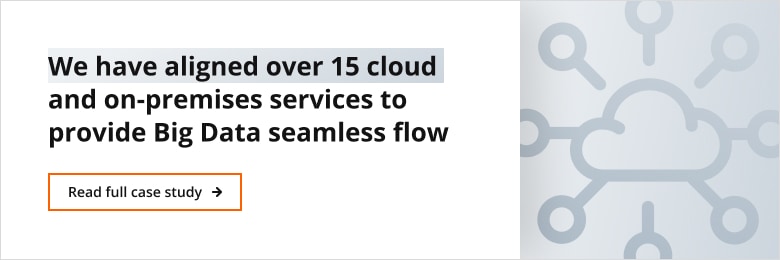
Cloud security: risks, challenges and what you can expect
When it comes to securing your data – one of the most valuable assets that you have – you need to be extremely careful in choosing a solution that complies with all the strict privacy standards in your industry, and that also offers tools that allow you to automate privacy-related processes.
What’s more, you have to handle data security wisely, preferably by moving to the cloud. And you should start the process right away. Exactly for this reason we’ve prepared a short crib sheet for you, hoping it will help you learn more about cloud security threats, security measures and what you can expect from the available cloud solutions offered by top providers.
Cloud computing security: what lies in wait for your data?
There is a popular belief that cloud services allow you to delegate the responsibilities related to software security. Some believe the cloud infrastructure is designed in such a way that it cannot be hacked.
But when we perform deconstruction, it becomes clear the external servers are as prone to attacks as the software launched on them.
The human component is another factor that can fail – while the Amazon Web Service or Microsoft Azure portfolios offer a lot in terms of automating administration, a large number of hazards is related to configuration flaws.
Unfortunately, the forecast in this area is ruthless: we have to get used to a new kind of hazards that await our organisations and enterprises within the world dominated by the cloud.
Cloud infrastructure being attacked at an increasing pace
According to Forbes analysts, by 2020 almost 85% of all enterprise workflow will be transferred to the cloud. Therefore, the interest in employing experts that specialise in similar migrations is no surprise.
Everyone who has had at least basic experience with Amazon Web Service realises that the key role in the process is played by the comprehensive knowledge of the AWS offering. To many, the number of offered services and microservices may be overwhelming.
Surely, there will be home-bred experimenters, who, without proper preparation or at least a basic knowledge of the documentation will attempt to test the novelties with the trial and error method, independently or using inexperienced teams.
This phenomenon may dominate the overview of the cyber threats within the enterprise segments in the following years. According to Gartner analyses, by 2022 95% of all security violations will be the fault of users and not cloud service providers.
The result of such a situation may be catastrophic, also due to the specifics of using the cloud infrastructure as database storage. As a result, even the single tiniest security incident, e.g. an effect of a faulty configuration or of using inadequate tools may lead to a giant data leak.
And the leak, especially if the incident is not properly managed, will expose the organisation to proportional fines, imposed by EU institutions and the GDPR directive.
Giant data leaks and advanced persistent threat
For years, the problem has been distant, as cloud transformation was the domain of the largest organisations, while to others it remained a catchy slogan repeated over and over in the industry media.
At the end of the second decade of the 21st century, cloud migration is a universal, mass process. It is not hard to imagine that the belief regarding delegating the responsibilities for the security of the infrastructure will lead to subsequent incidents, respectively to the universality of the migration.
Obviously, the providers themselves do not remain idle in the face of similar forecasts, which can be demonstrated by various services launched along with the infrastructure that users receive at their disposal.
It’s enough to name Amazon Web Service Security Hub to realise that mechanisms dedicated to the proactive recognition of bad configurations as well as of various other elements that may be a potential source of vulnerabilities qualifying for the CVE signature already exist.
In the worst-case scenario, the exploitation of the aforementioned may result in an Advanced Persistent Threat breach that will last many months. It is not only the security of the databases and the risk of their leaking that are at stake, but also all workflow that is processed by the organisation on external servers.
The one who executes an APT attack will obtain incredibly vulnerable information, including priceless know-how. It is not without a reason that APT (and other common Big Data Security risks) are listed next to global ransomware campaigns and the supply chain takeovers as the greatest threats for the IT enterprise environments at the time.
4 common cloud security risks and issues
While cloud computing offers numerous benefits, it is important to know about its security threats and risks. Here are four common ones:
Unmanaged Attack Surface
In the context of cloud security solutions, the unmanaged attack surface refers to the vulnerabilities and potential entry points within an organisation’s cloud infrastructure and services that are not properly identified, monitored, or controlled.
It encompasses the areas that are often overlooked or not adequately managed, providing opportunities for attackers to exploit.
Some specific factors related to the unmanaged attack surface in the cloud environment include:
Unauthorised Cloud Instances
Employees or departments may create cloud instances or deploy services without proper authorisation or oversight from the IT or security team. These unauthorised instances can introduce security risks as they may lack proper security configurations and controls, leading to potential vulnerabilities.
Unprotected APIs
Application Programming Interfaces (APIs) are used to connect and interact with cloud services. If APIs are not properly secured, authenticated, or validated, they can become an entry point for attackers to access sensitive data, manipulate services, or launch attacks on the cloud infrastructure.
Unused or Forgotten Assets
Over time, organisations may have cloud resources, such as virtual machines, storage buckets, or databases, that are no longer in use or forgotten. These unused assets often remain unmonitored and can be targeted by attackers who exploit the lack of security controls or misconfigurations associated with them.
Inadequate Security Configuration
Improperly configured security settings in cloud services can create vulnerabilities. This can include weak access controls, misconfigured permissions, open ports, or unencrypted data. Without proper configuration management and regular security risk assessments, the attack surface expands.
Lack of Visibility and Control
Cloud environments can be complex, dynamic, and highly scalable, making it challenging to have complete visibility and control over all assets and activities. Inadequate monitoring and logging practices can result in a lack of awareness of potential security threats and incidents, making it easier for attackers to operate undetected.
Human Error
Human error is a significant cloud security risk that organisations need to address. Despite having robust security measures in place, human mistakes can lead to security vulnerabilities and breaches. Some common examples of human errors in the context of cloud security include:
Weak Passwords
Employees may use weak passwords that are easy to guess or reuse passwords across multiple accounts. This makes it easier for attackers to gain unauthorised access to cloud services or compromise sensitive data.
Misconfiguration
Human errors during the configuration of cloud services can result in security misconfigurations. This can include granting excessive permissions, leaving unnecessary ports open, or failing to implement encryption properly. Misconfigurations can expose cloud resources to unauthorised access or make them vulnerable to attacks.
Phishing and Social Engineering
Employees may fall victim to phishing attacks, where they unknowingly provide their login credentials or sensitive information to malicious actors. This can compromise their accounts and provide attackers with unauthorised access to cloud services.
Unauthorised Access
Employees may unintentionally or maliciously access and misuse data or resources that they are not authorised to use. This can occur due to inadequate access controls, lack of employee training, or failure to revoke access privileges when employees leave the organisation.
Lack of Security Awareness
Employees who are not properly trained on cloud security best practices may inadvertently engage in risky behaviours. For example, they may upload sensitive data to insecure cloud storage, share confidential information with unauthorised individuals, or neglect to follow proper data handling procedures.
Bad service configuration
The aspect that cannot be omitted is the issue of the repetitiveness of cloud service configurations. A known example of the issue was the data leak after gaining unauthorised access to the infrastructure of the Capital One bank holding company. In July 2019, as a result of gaining unauthorised access by third-party individuals, data of 100 million Capital One customers from the US and 6 million customers from Canada was stolen. It was one of the largest data leaks in the American financial sector’s history.
The case has become an object of an FBI investigation. It was determined that the incident was a result of a faulty AWS S3 bucket configuration. Losses resulting from the Capital One leak were estimated at approximately 150 million dollars. However, the most striking thing was the federal investigators’ report stating that this particular bad S3 configuration was used in at least 30 other organisations that often process extremely vulnerable data.
Read more about: “Cybersecurity in the financial sector: how to prevent potential threats?”
Data Breaches
Data breaches pose a significant security risk in cloud computing environments. A data breach occurs when unauthorised individuals gain access to sensitive or confidential data stored in the cloud, leading to potential misuse, theft, or exposure of that data.
Here are some key factors related to data breaches in the context of cloud security:
Unauthorised Access
One of the main causes of data breaches is unauthorised access to cloud resources. This can happen due to weak or compromised user credentials, inadequate access controls, or vulnerabilities in the cloud provider’s infrastructure.
Insider Threats
Insider threats refer to risks posed by individuals within an organisation who have authorised access to cloud resources. These individuals may intentionally or unintentionally misuse their privileges, leading to data breaches. Insider threats can include employees, contractors, or third-party service providers with access to the organisation’s cloud environment.
Insecure APIs
Cloud services often expose APIs (Application Programming Interfaces) that allow interaction and integration with other applications and systems. If these APIs have security vulnerabilities or weak authentication mechanisms, they can be exploited by attackers to gain unauthorised access to data or manipulate cloud resources.
Inadequate Encryption
Insufficient or improper encryption practices can expose sensitive data to unauthorised access. If data is not adequately encrypted when stored or transmitted, it becomes vulnerable to interception or extraction by attackers.
Data Loss or Leakage
Data breaches can occur due to accidental data loss or leakage, where sensitive data is inadvertently exposed or shared with unauthorised parties. This can happen through misconfigured cloud storage, accidental public sharing of files, or improper handling of sensitive data.
How cloud solutions take care of your security
Compliance with external privacy laws and regulations
Following changes in the law and politics not only requires hiring security experts but often lawyers as well. And the bigger you get, the more assistance from them you’ll need. Cloud solutions automatically adhere to any new regulations, like the GDPR or EU Standard Contractual Clauses, so you don’t have to worry about this at all.
Data security at rest and in transit
Storing your data and moving your data between different devices require properly secured, state-of-the-art encryption algorithms and protocols – all of them are provided by cloud solutions.Protection against cyberattacks
The constant monitoring and early detection of any cyberattack attempts are yet some more things that help you rest assured regarding your data security. In the cloud, data is much more well-protected from any external threats than it would be on-site.Protection against physical damage to data centres
You can often choose where you want to store your data and any copies of it. Replicating data makes it disaster-proof – you can make a specific number of copies and place them in several data centres for security reasons.Data deletion once the customer stops using the solution
Due to privacy reasons, cloud providers are legally obligated to delete any data upon contract termination or at the client’s request, so you and your customers are well-protected in this matter.
All of these things are important regardless of the circumstances in which a business may be operating, but the COVID-19 pandemic has definitely caused the demand for cloud solutions – along with their privacy options – to escalate rapidly.
The cloud security in the time of COVID-19 and after
This absolutely unprecedented shift in the external environment has forced many companies to accelerate their digital transformation processes, so that they maintain their position in the market and are prepared for future emergencies. Naturally, interest in leveraging the cloud has accelerated as well. More companies have started working remotely, using more tools for remote collaboration and demanding cloud infrastructure for data storage and transfer, in order to strengthen their security and operate more efficiently.
According to Deloitte, what now seems to be the future of managing cloud complexity is a combination of multiple cloud solutions, federated security and distributed DevOps.
Multicloud strategies
Multicloud strategies involve choosing multiple cloud providers (this includes, for example, a hybrid cloud strategy – using both public and private solutions). The main challenge here is in how to securely and efficiently manage data and workflows across different clouds.
And this is connected to the next big topic that is gaining traction these days – federated security. This model not only lets you separate the service that a client is accessing from the procedures associated with authentication and authorisation, but also allows you to securely collaborate across multiple networks and systems.
And last but not least, there are distributed DevOps strategies that support all of the above. DevOps improves performance in remote, heterogeneous environments – especially when scaling up. They support automation and flexible collaboration, and take care of processes and concepts that make software better and more reliable.
How you benefit from customer data protection in the cloud
By moving to the cloud, your level of organisational security skyrockets immediately.
The benefits you gain cannot be overlooked since they affect every area of your business:
You can automate security tasks to help your projects progress faster.
Automation allows your security experts to focus on management rather than on doing repeatable tasks one by one, over and over again.You have full control over your data and in-depth visibility into data-related processes.
Cloud-based access control and the real-time monitoring of any security information are possible no matter where in the world you choose to store your data.You can scale up more efficiently.
This is because your specialists are not involved in the processes that the cloud solution handles. Moreover, this also provides you with the proper infrastructure for scaling up with ease.Your customers see this as a sign of increased reliability and dependability.
When your customers are confident that their data is being securely stored, they will be more keen to buy your products or services.You are always up to date with the latest security standards.
And you don’t have to follow any changes in the laws and regulations, or make any efforts to adhere to them. This saves you a significant amount of time.You maintain business continuity in case of any emergency within your company.
Even if you experience physical damage to your devices or other parts of your infrastructure, it won’t affect your data.You can detect data breach attempts early on and respond to them quickly.
The system will inform you straight away in case of any threats, so you can react accordingly.
Sounds appealing, doesn’t it?
Cloud data security: what can be done?
One cannot say without a clear conscience that the new cyber threat reality must be tackled with new means. Quite contrary, the implementation and the meticulous realisation of the norms, accomplished already at the local level, may significantly influence the softening of the disturbing trends.
Nowadays, moving to the cloud seems to be both a convenient and necessary option; it’s a vital part of any digital transformation. And it’s a big move for any company.
If you want to run any system penetration testing and check the security of your new or migrated system with architecture based on cloud, our expert can do it for you.
We also offer Cybersecurity Consulting, if you would like more in-depth information on the security of your projects. Do get in touch!





